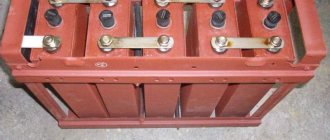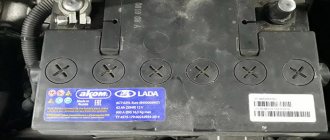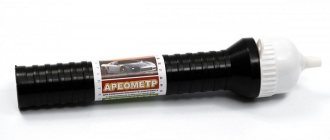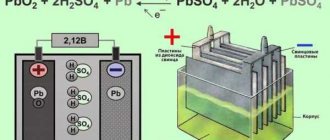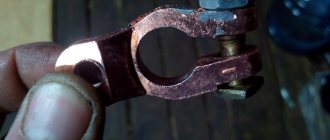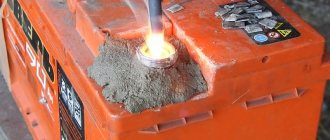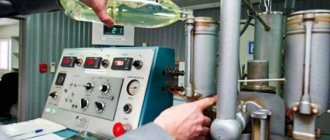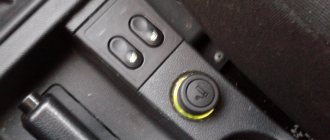The main reasons why the electrolyte turns black
Experienced motorists know that the battery is filled with a clear liquid, which is a mixture of distilled water and sulfuric acid, combined in a certain proportion. The solution in each new battery is absolutely transparent, because it does not contain any dyes or chemical additives.
Destruction of battery plates
With proper operation and in good condition, the working electrolyte in the battery banks will continue to be cloudy, and the reasons for the loss of transparency can be various factors
It is important to pay attention when negative factors appear that cause the electrolyte to darken. This may not happen in all jars at the same time, but only in one of the working containers
In this case, there is nothing unusual, because the electrical appliance is designed for a certain period of use, and after its service life expires, it is completely replaced, and not restored to its operational characteristics. In fact, the owner has no ability to influence the composition of the solution.
Users of maintenance-free devices sometimes experience cloudy liquid composition if owners drill holes in any cans and then do not seal them well. You should not do this unless absolutely necessary, since third-party interventions usually do not lead to a positive result.
In a serviced battery, you are less likely to encounter cloudy electrolyte, since the reason lies in regular monitoring of the fluid by users. By unscrewing the plug, the car owner can check the condition at any time and take the necessary measures in a timely manner.
Popular causes of cloudy fluid in the battery include:
- For old batteries with a long service life, a popular cause of contamination is the penetration of small debris and dirt into the container. This occurs due to wear of the plugs or under-tightening of the threads, as well as due to self-unscrewing.
- When charging the battery, the liquid inside may boil and evaporate. Then the owner adds water. If it is not distilled, then the salts present in it can lead to deposits during subsequent charging. Further impurities give rise to turbidity.
- You should not use low-quality ready-made electrolytes in unknown places. Even with a short period of use, the composition can lose transparency and quickly fail.
The problem with cloudy liquid can be solved by completely replacing it with fresh one. In this case, it is necessary to observe the proportions when preparing it yourself. After changing the composition, the battery is suitable for further use.
If preventive measures are not taken, the battery will overcharge and further overheat. Excessive temperature will cause the solution to change color to a darker shade. Deviations in the operation of the on-board power supply will affect the performance of the generator, relay regulator, and external charger. The composition can also negatively affect the built-in plates inside the case, which will lead to their further destruction.
Checking the electrolyte for replacement
The color change occurs due to the destruction and splitting of the plates. This happens due to a significant discharge of the battery. This changes the color of the liquid.
A decrease in density affects the possibility of freezing of the composition at low temperatures. Increasing the amount of water in the composition in this way can lead to mechanical destruction of the walls of the cans and the body as a whole when freezing.
Factors leading to darkening of the electrolyte
Transparent battery mixture may change color when exposed to several factors:
- Contaminants will change the condition of the fluid, and dirt, lubricant, and coolant mixture can enter the acid composition through insufficient tightness (for example, poorly tightened plugs) or their destruction. These elements cause a cloudy solution.
- Running water on contact with the mixture may change its color. Poor quality water for filling jars regularly spoils its condition and performance. In hot weather conditions, the car owner adds water to it. In this case, it is a mistake to use undistilled liquid; the pure solution will become cloudy. The root cause is also the use of low-quality or incorrectly prepared acid mixture, which can be purchased at unreliable retail outlets.
- A low-quality battery with low fluid properties is often supplied in a dry charged state. To avoid this problem, you need to choose a battery in a specialized store.
- Significant overheating of the device during charging will cause a deterioration in the quality of the solution. It will turn into a cloudy solution. Overheating can occur when the battery is left on charge for a very long time and is not monitored, the relay regulator or the charger itself, which operates from the mains, breaks down. Incorrect charging current will also cause the liquid to change color.
- Completely discharging the battery will definitely affect the coloration of the acid and water mixture. To prevent this problem, you just need to regularly monitor the operation of all car electrical appliances, check that everything is turned off when you leave the car in the garage or in the parking lot.
Taking into account all the described factors that negatively affect the composition, it is possible to prevent equipment failure.
Why is the battery's electrolyte cloudy?
Why do the battery terminals oxidize?
Why is the battery's electrolyte cloudy?
In a working battery, the electrolyte should be transparent. It becomes cloudy due to the presence of foreign impurities. The simplest reason is dirt getting inside the battery.
The electrolyte may lose transparency when adding adulterated distilled water or regular tap water with a high content of chlorine and iron. It will also darken if you add electrolyte yourself. We do not recommend adding market-made “electrolytes”, since their actual composition, quality and density are unknown.
If all of the above is excluded, and the electrolyte in the battery is cloudy, then the main reason for the presence of foreign impurities is overcharging. In case of overcharging, particles of grease from the electrodes fall off and fall into the electrolyte. The reason for overcharging may be:
— faulty generator or relay-regulator “tablet”;
- charging with homemade chargers or cheap Chinese chargers, which do not so much charge the battery as “boil” it with high voltage and current;
— operation in “taxi” mode, in which the battery does not have time to discharge and the charged battery is constantly charged.
Gray deposits in the electrolyte are undissolved sulfate crystals, which signal the need to recharge it. In this case, after the battery is fully charged, the electrolyte returns to its transparency.
A dark, brown or red tint of the electrolyte means that most of the grease from the plates has fallen off and you will have to buy a new battery.
We would like to warn you against blindly following recommendations from the Internet, which will lead to dire consequences for your battery! Here are some “tips” we came across:
“Snow is distilled water and can be added to the electrolyte.” Snow is definitely not distilled water.
“If the electrolyte is cloudy, you need to drain it, rinse the battery with water and fill it with a new one bought at the market.” Replacing the electrolyte with washing the battery was practiced in the 70s with antimony batteries. In a modern calcium battery with tightly spaced electrodes “clad” in separator bags, it is impossible to pump out the old electrolyte along with the sludge. Pieces of sludge will get stuck between the electrodes and set the stage for the subsequent formation of bridges and short circuits. There are many nuances with the manufacture of a new electrolyte, the formation of calcium sulfate on the electrodes upon contact with water. Result: wasted time, money and a dead battery.
“Add a modifier that will clean the electrolyte and give new life to the battery.” Our motorists are already well aware of nanotechnologies that repair old engines and magnetic fields that save fuel. And now there are modifiers (of a secret chemical composition), which transform for only 100 UAH. old battery into new one.
Cloudy electrolyte is not the death of the battery, but it is a sure sign that the battery requires urgent replacement.
If you notice a deterioration in the transparency of the electrolyte, you can try to let the battery sit without charging. Perhaps impurities will settle to the bottom. But you shouldn’t hope for a reliable and long service life of such a battery. The processes of oxidation of the plates are already underway in it, the access of the electrolyte to the active mass is closed, and the lubricants are destroyed. At any moment, a short circuit may occur between the plates due to pieces of grease stuck there, which will make it impossible to operate your car. In practice, cloudy electrolyte is observed either in low-quality batteries or in “aged” batteries that have expired.
Cloudy electrolyte is a signal to the owner that he needs to buy a new battery!
Electrolyte replacement
If manipulations with charging do not produce any results, then we move on to more effective measures. To do this, you first need to purchase a new electrolyte. In the store composition, the density is 1.31-1.34 g/cm3. However, for operation you will need an electrolyte with a lower value (1.27-1.29 g/cm3). To achieve this result, the finished composition is diluted with a small amount of distillate. After that:
- We clean the outer part of the battery case (so as not to accidentally introduce dirt into the jars during the process of replacing the fluid).
- We unscrew the caps of the cans (all) and remove the cloudy electrolyte.
Healthy! If you are trying to replace the fluid in a maintenance-free battery, you also need to pry it with two screwdrivers and remove the hydrometer (eye).
- We wash the inside of the battery so that there is no sediment left in the jars (you can only use distilled water and chemical cleaning fluids).
- We pour new electrolyte into the battery compartments and set it to charge at a current of 2A. During charging, the voltage should be checked periodically.
When the battery is fully charged, it is necessary to evaluate the quality of the solution, its density and level. The composition should cover all plates in each jar. At the same time, its density should remain at the same level (1.27-1.29 g/cm3). If after some time this indicator decreases, you will have to completely replace the battery.
Reasons for solution turbidity
Why does oil get into the air filter, the main reasons, what to do, how to avoid the problem Why does oil get into the air filter and what to do
The electrolyte is a mixture of distilled water and sulfuric acid. This environment ensures ideal discharge passage. A new and serviceable battery should not contain any impurities or cloudiness, because this indicates a manufacturing defect. If you see dark electrolyte in a battery that you have already used, there may be several reasons for this.
What affects the purity of the solution:
- The simplest and at the same time unlikely reason is dirt getting inside. This can happen due to unqualified maintenance or depressurization of the container, which will entail a number of other problems.
- Adding the wrong fluid to the battery. It is necessary to use only distilled water; ordinary tap water will not work. Over time, plaque will form in it, which will disrupt the purity of the solution. In addition, you need to make sure of the quality of the purchased liquid and certainly not use improvised means in the form of mineral water or snow.
- Failure of a maintenance-free battery. Most often, the electrolyte in the battery darkens for this reason. The fact is that such devices are designed for a certain service life, so during testing they can “signal” with cloudy electrolyte, even while continuing to work for some time. You should not delay replacement, because in addition to darkening the solution, the main functions of the device may also be impaired.
- Freezing of the electrolyte solution. Despite the fact that the liquid in the battery has a low freezing point, this can also happen in severe frost. The appearance of ice inside the battery can damage the internal surface of the case and plate, which can also manifest itself in the form of sediment and cloudiness.
- If the electrolyte darkens while charging the battery, the battery may be overheating. Strong heating of the battery, especially in the summer, has a detrimental effect on its further operation. Already at 37-40 degrees, the liquid may darken and form a sediment, so you should avoid overcharging the battery and exceeding the recommended charging period.
- The battery was very low. Such conditions are also detrimental to the normal operation of the battery. You should not allow a complete discharge, because in this case the electrolyte can also change its transparency.
What is also important is the extent to which the solution darkened. If we are talking about one section, the problem is quite simple to solve. If the solution darkens in all compartments at once, malfunctions or complete failure of the battery will also be observed.
Dark electrolyte in the battery: what to do in this case
First of all, it is necessary to visually assess the condition of the electrolyte, that is, what color the liquid is (gray, black or just cloudy). Next, you need to pay attention to whether the color change occurred in one jar, in several, or in all of them at once.
Now let's consider the situation when black electrolyte is detected in the battery, what to do if the liquid becomes cloudy or changes color to gray, etc. First of all, cloudy electrolyte in all sections without exception may indicate that low-quality water or acid was previously used. In this case, replacing the electrolyte will help.
To do this, you need to drain the old electrolyte from the battery, and then fill it with fresh solution. If no further darkening or clouding is observed during operation, then this means that these actions helped keep the battery in good condition.
The gray color of the electrolyte in all battery banks indicates that you should first try to charge such a battery, since crystallization of sulfuric acid salts has occurred. This results in severe battery discharge. If the charge does not help, then you can try rinsing the jars and replacing the electrolyte, and then cyclically charge the battery with weak currents, alternating charge and discharge.
Significant turbidity and blackening of the electrolyte in one section is a reason to replace the electrolyte only in that section. At the very beginning, you need to measure the voltage in this bank. Readings around 2.1 V indicate that there is still a chance to restore the battery.
If there is no voltage or the indicator on the can is minimal (does not exceed 0.5 V), and the total voltage at the battery terminals is about 10.5 V, then there is a high probability of the can completely falling apart. In other words, the lead from the plates colored the electrolyte black and precipitated.
We also recommend reading the article about what to do if the electrolyte in the battery freezes. From this article you will learn about the reasons for freezing of liquid in the battery case, as well as methods for defrosting and restoring the battery.
The problem is that lead residue causes the plates to short out. It turns out that the section is not working, there is no voltage on it. In this case, you can try changing the electrolyte, but it is better to immediately prepare to replace the battery.
It is important to consider that large-scale shedding of the plates will not allow the battery to return to the required performance, even taking into account the refilling of fresh electrolyte. This statement is true both in relation to one non-working section and to the general destruction of the plates in all battery banks.
How to protect yourself and how long the battery lasts
What to do if the brake pedal hits when braking, causes, consequences. Beats when braking
Guys, the average life of a good battery is about 5 years! Well, there are at least three “bullshit” ones. After this period, degradation of the plates appears - deformation, there is no escape from this. But even after five years, the battery can be saved by simply desulfating it; a friend of mine has been riding for about 8 years on 1 battery; he simply restores its capacity every three years with a special charger.
However, it is worth noting that this process is not always possible, it is not always possible to restore the capacity, because there may be internal irreversible consequences, for example, destruction of the plates. But it’s always worth a try, I’ll tell you how soon.
Now let's watch a useful video.
I’ll finish this, read our AUTOBLOG.
How to determine sulfation
I would like to talk - how to determine this process in a battery? Of course, I’ve already touched on a little from above, but here I’ll sum it up!
If you have a serviceable battery, that is, there are plugs on top that unscrew, you need to look at the plates. If they are covered with a light coating, white-brown, it means that the process has started and is thriving.
- When charging, the battery begins to boil very quickly, and the temperature of the electrolyte rises very quickly. Let's say in 30 minutes, it's fully charged and boiling.
- After the battery is fully charged, it does not start the engine, and a regular lamp (say from a headlight) puts it below zero in 5 - 10 minutes
- The battery capacity drops catastrophically. After measurements, it produces approximately 10 - 40% of the total capacity. That is, you have, say, 60 Am*h, but there are 6 – 24 Am*h left, and 30 – 40 Am*h, which is also not enough!
- Frequent boiling of the electrolyte and, as a result, a white coating. If it constantly forms on your car batteries (you wipe it off, but it appears again), you should think about it and check the capacity.
These are actually the main “signs”; as a rule, owners notice them after the engine does not start.
Why do jars boil and is this normal?
YES this is quite normal, it shows us that the battery is charged, which is why off-gassing begins. Under the influence of electric current, water begins to disintegrate into volatile hydrogen and oxygen, they rise upward in the form of bubbles. It should be noted that this gas is very explosive - if a spark gets on it or there is an open flame nearby, then the battery can easily explode, no matter how little it seems.
If there are bubbles, then it means it’s time to remove the battery from charging; overcharging will also not bring anything good - the intensity of the bubbling will only increase, the water level in the “jars” will rapidly fall, as water leaves the electrolyte. Next, the plates are exposed (which must be completely immersed in the electrolyte), they will begin to heat up and then their destruction is possible.
Some car enthusiasts deliberately bring the battery to the point of gas evolution, the whole point is that - in this way you can increase the density of the electrolyte - “catch up” with it to the desired value. After all, the water boils away, but the acid remains - thus, the density increases.
Therefore, you can wait for bubbles, but without fanaticism, give low currents, otherwise it will boil intensely, which can really destroy your battery.
Electrolyte density measurement
The density of the electrolyte in the banks directly determines the battery’s ability to accept a charge. Density is measured only for a fully charged device that has been left at rest for a couple of hours at a temperature of about 25 degrees Celsius. If you measure immediately after charging, the readings will be too high.
Density is measured in grams per cubic centimeter and in normal climates should be 1.25-1.27 g/cm3. In colder regions it is increased to 1.29 g/cm3. Accordingly, the density level in warm regions may be 0.01 lower.
You can measure density readings yourself using a special device - a densimeter. It is a glass tube with a hydrometer inside. It is connected to a plastic tube on one side and a rubber bulb on the other. To measure, you need to slightly open the jar of electrolyte, immerse the plastic end of the tube into it and, by pressing the bulb, scoop out a little electrolyte. The aerometer will show the density. In a similar way, you can check the density of the battery model being serviced.
To check this indicator for a maintenance-free battery that does not provide access to the existing electrolyte, just look through a special window. At a normal density level, a green indicator should be visible in it. As the density decreases, the indicator will turn black.
If the density of the electrolyte is below normal, this does not necessarily mean that it needs to be topped up. When the battery boils, only water can evaporate from the liquid composition. Sulfur remains in the composition, but can accumulate around the lead plates, leading to sulfation. If the process is not yet very started and only a small part of the sulfur crystals have accumulated at the lower edge of the plates, you can correct the situation by performing several charge/discharge cycles of the battery.
IMPORTANT! Electrolyte can only be refilled if it was spilled due to carelessness or accident. It is important that the density and temperature of the two compositions fully correspond to each other
Cloudiness of the electrolyte
There are several reasons for this phenomenon. Many people believe that the whole issue is dust that got into the battery banks. However, this happens extremely rarely, especially when it comes to maintenance-free batteries, which are actually sealed containers. Therefore, we immediately cut off this reason.
If the liquid is cloudy, then it is worth remembering what kind of water was used when servicing the unit last time. You need to remember once and for all, you cannot use tap water, even if it looks very clean and transparent (and even more so process water). Only distilled liquid is suitable.
Sometimes the electrolyte remains relatively transparent, but inclusions appear in it, which form a precipitate. This indicates that we had to deal with sulfation of the plates.
If the liquid becomes cloudy and acquires a gray or lead-like tint, this indicates a severe discharge of the battery. Fortunately, all these problems can be solved on your own, without replacing the electrolyte or buying a new battery.
Causes of sulfation
Low temperatures. Low temperature itself does not affect the sulfation process, but it affects the entire car as a whole. It takes a lot of energy to start, and a cold battery charges worse, that is, it essentially does not receive the required “portion” of charge. So the process has been triggered for you. Short trips aggravate the situation, for example, you work 15 minutes from home, during which time the engine will not have time to warm up properly, I’m already silent about the battery! Therefore, winter is the “real killer” of batteries.
- Heat. Yes, don’t be surprised - she doesn’t bring anything good either! The thing is that in the summer under the hood it’s 60 – 70 degrees! With such indicators, all processes are accelerated, including the process of sulfation of the plates, especially strongly if the battery is slightly discharged. At such extreme temperatures, crystals settle and clog the working surfaces.
- Adding concentrated electrolyte or acid. If you have determined that you already have sulfation, and are trying to “melt” the crystals, increasing the density of the electrolyte, by adding pure acid or “concentrate” of the electrolyte (usually with a density of 1.4 - 1.45 g/cm3), then you have nothing will not work. On the contrary, you will aggravate these processes even more! Don't do this.
- Long-term storage in an undercharged state. The battery tends to discharge over time, even if you store a fully charged version for a long time, say for six months or even a year, it will lose 30% of its charge after 4–6 months and up to 50–60% after a year (I’m talking about acid batteries now). battery). So, sulfate is formed, but no one removes it, there is NO charge! The crystals begin to “harden” as they say, and the longer you do not charge it, the greater the likelihood of critical sulfation.
Whatever one may say, battery degradation occurs almost always; sulfation is very difficult to avoid, even if you do everything correctly, hot summer weather will do its job! After summer, it is advisable to measure the residual capacity of the battery and, if necessary, desulfate it.
What to do?
Often, on forums, you can see this - there was a brown electrolyte, density 1.15 (or, say, 1.17), charged to 1.27 g/cm3, everything became fine, the brown color went away.
Guys, he didn’t go anywhere, he simply settled to the bottom of the jar and is there in the form of sediment. The active mass from the plus plate has already crumbled and it will no longer be possible to restore it back. THIS IS REALLY BAD FOR YOUR BATTERY!
You just have to hope that the shedding is not so intense and that your battery will last at least for how long! After all, the mass may crumble a little, or the plus plate may completely collapse, leaving a brown sediment at the bottom of the jar.
What they suggest online is to rinse the jar/cans, replace the electrolyte with a new one and charge the battery! DO NOT DO THIS UNDER ANY CASE. Why? Yes, it’s very simple, when you start washing the jar, you will pick up the already fallen sediment from the bottom, these “scales” can get stuck between the plus and minus plates, thereby completely bridging the jar. IT JUST WILL NOT WORK.
Thus, just do not touch the battery, charge and drive until it logically dies. BUT remember that it is already nearby, and for example, for a winter launch, it may not be enough.
That's all for me, but now a short video about how to CORRECTLY charge your battery.
Sincerely yours, AUTOBLOGGER.
Similar news
- How to light a battery from another car. Is it possible to do this...
- Which company (brand) to choose a battery for a car. My rate...
- Lubricating battery terminals. Why does a car need this?
Add a comment Cancel reply
Cloudy electrolyte in the battery - FordLab all about Ford cars.
Cloudy electrolyte
Inside a new battery is a clear electrolyte, when this active material can no longer support the discharge current, the battery "dies". Typically, a battery "ages" when the active positive plate material is lost (or peeled off) due to the normal expansion and contraction that occurs during discharge and charge cycles. When the container is lost, a brown (brown) color called sludge or "dirt" may appear that accumulates in the bottom of the housing. So let's talk about cloudy electrolyte, how to prevent and eliminate it.
Why is the electrolyte cloudy?
The most common cause of cloudy electrolyte is simple dirt. The reason is trivial, but if dirt gets inside, the performance of the battery will deteriorate and will need to be replaced.
The best batteries
A cloudy electrolyte may appear due to topping up distillate. Adding distillate with the wrong chlorine and iron content will result in a cloudy appearance. We do not recommend taking a poor quality distillate, and do not mess with the electrolyte at all (it may have the wrong composition/density).
If the reasons described above do not apply to your situation, then it could become cloudy due to overcharging. When recharging, the grease sheds from the plates, the sediment of which gives a brown color. Recharging may be due to poor battery charging, or the battery does not have time to recover from travel or due to increased/lower temperatures. In summer, a cloudy tint appears due to strong heating, and in winter, a common cause is thawing of the battery.
Read where to find the radio code for Ford Focus 2
ATTENTION! You cannot fill the battery with ordinary water. Ordinary water contains all sorts of impurities and metals
Gray shade
In this situation, your battery contains a lot of insoluble sulfates. You need to fully charge the battery and the color should be restored.
Electrolyte recovery
Yes. It can be restored, although not always. Before restoring the electrolyte, you need to find the cause of its cloudiness. In the best case, with a gray tint, you will only need to charge it, and in some cases, buying a new battery will help.
Electrolyte replacement process
Let's sum it up
As you can see, cloudy or gray electrolyte is not always a sign of final battery failure without the possibility of recovery. In this case, you need to take a comprehensive approach to the maintenance issue, that is, wash the sections, fill in fresh electrolyte according to the level, and adjust the density. Next, you need to properly charge the battery.
If blackening of the electrolyte is noted in one or more banks, and the voltage is low or absent, then this indicates active shedding of the plates. For a number of reasons, it is better not to waste time trying to restore such a battery, since even if positive results are achieved, there is no confidence that the device will continue to operate normally for a long time (especially in low temperature conditions).
It turns out that if the gray electrolyte is not yet so critical, the black electrolyte in the jars is already a good reason to scrap the existing battery and purchase a new battery. We also note that if there are problems with the generator in the car itself or when charging from the charger the battery is not charged correctly, then the new battery will quickly fail.
Summing up
Oddly enough, if the electrolyte has become cloudy or gray in all banks, this is a pretty good signal. In such a situation, there is a high probability that the reason lies in the poor quality of the previously filled liquid, or simply in the strong discharge of the power source. The situation can be corrected by changing the solution and connecting the battery to a charger.
But when one can becomes cloudy or black, and at the same time the engine does not start, then we have to talk about shedding of the plates. Recovery is possible, but not in all situations. A more reasonable and correct solution would be to replace the battery.
